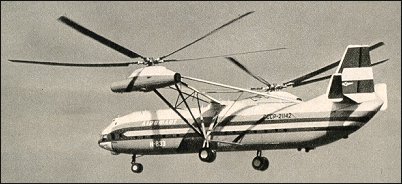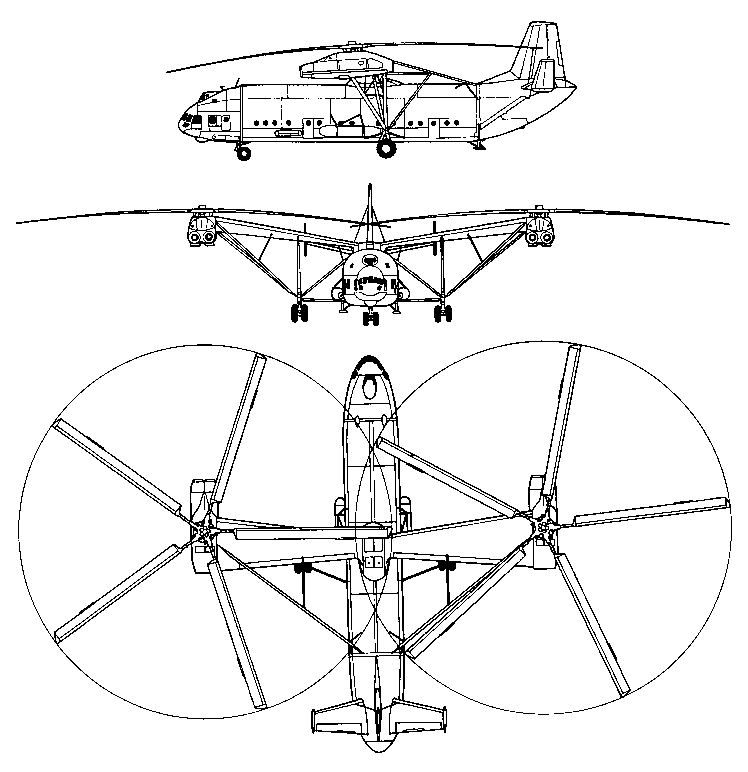1969
 |
 |
The Mil Mi-12, known as V-12 in the Soviet Union, and by the NATO reporting name Homer, is so far the only helicopter produced by the Mil bureau to depart from the single main rotor plus tail rotor formula. It is to date the world's largest helicopter and flew for the first time in 1968, but did not enter production. The second prototype, which was presented in the West at the 1971 Paris Air Show, set seven load-carrying records in 1969: in February, a 31030kg load was lifted to 2951m and the following August, 40204kg was taken to 2255m.
The Mi-12 project was started in 1965 with the aim of producing a vertical take-off aircraft capable of carrying missiles or other loads compatible with those of the four-engine An-22. The bureau chose the side-by-side rotor formula in order to use the engine-transmission-rotor assembly of the helicopters of the Mi-6 / Mi-10 series with minimal modifications. Two of these assemblies were in fact mounted at the tips of the two short wings, which had an inverse taper from the root to the wingtips. The engines were 6500shp Soloviev D-25VF turbines giving the helicopter a maximum speed of 260km/h, with a 35400kg load and 500km range. The large cargo hold measuring 28.15m long by 4.4m wide could take various kinds of loads, including very bulky ones, as well as troops or handling crews. The fuselage had a conventional, semi-monocoque structure, with large clamshell loading doors at the rear to facilitate handling of bulky loads. The flight deck was on the upper floor of the cabin and there were six crewmembers. On the ground, the helicopter was supported by large, fixed tricycle landing gear with two wheels on each unit. A large end-plate fin tail unit was mounted at the rear of the fuselage, with moving vertical and horizontal surfaces.
As well as being designed for military use, the Mi-12 was probably intended for service with Aeroflot, especially for deployment in areas of Siberia which are rich in resources but which have very poor communications. Technical problems were almost certainly responsible for development of this aircraft being abandoned in favour of the Mi-26.
G.Apostolo "The Illustrated Encyclopedia of Helicopters", 1984
* * *
The V-12 had a fuselage and tail unit more akin to a fixed wing trans-port and was lifted by two Mi-6 rotors mounted at the ends of outrigger wings. A pair of D-25VF turbines was fitted at the tip of each wing to power the rotors. With the crew perched in a cockpit above the nose the V-12 had an unobstructed cabin capable of carrying 120 passengers. Unfortunately, testing of the V-12 started with a disastrous heavy landing and the Mil team experienced major stability difficulties with the two remaining prototypes. The performance of the V-12 never matched that of Mil's other large trans-port helicopters and it was eventually abandoned.
R.Simpson "Airlife's Helicopter and Rotorcraft", 1998
* * *
Хотя было построено только два опытных экземпляра вертолета Ми-12 (В-12), эта гигантская машина знаменита тем, что является самым большим вертолетом в мире. Несущий винт, трансмиссия и силовая установка были взяты от вертолета Ми-6, но продублированы и расположены на концах неподвижных, подкрепленных ферменными подкосами консолей крыла. Четыре турбовальных двигателя Соловьева Д-25ВФ имели суммарную мощность на валу 19388кВт, что позволило вертолету В-12, впервые поднявшемуся в воздух 10 июля 1968 года, установить в феврале 1969 года серию рекордов, которые, будучи представленными для утверждения, явились первым полученным на Западе сообщением о существовании этого гигантского вертолета. Позже, 6 августа 1969 года, В-12 поднял полезный груз 40204.5кг на высоту 2255м, установив рекорд, который до сих пор не превзойден.
Первый опытный экземпляр был разрушен при посадке (при этом никто не погиб) в 1969 году. Второй Ми-12 участвовал в демонстрационных полетах. Ограниченные потребности в таком классе машин сделали его дальнейшую разработку неэкономичной.
 |
Характеристика вертолета Ми-12
Экипаж: 6-10чел, силовая установка: 4 x ГТД Д-25ВФ мощностью по 4780кВт, диаметр несущих винтов: 35.0м, размах крыльев: 67.0м, длина: 37.0м, высота: 12.5м, взлетный вес: 97000-105000кг, вес пустого: 60000кг, максимальная скорость: 260км/ч, крейсерская скорость: 240км/ч, динамический потолок: 3500м, дальность полета: 800км